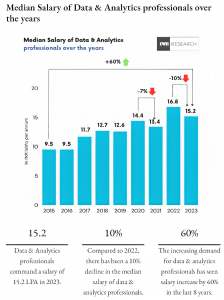When the question arises about the preferences of SAS vs R, the answer always depends on the job industry. Learners will always prefer to learn languages to help them sustain in the data world. The recent shift happening in the data world with the increasing benefits of R has opened the eyes of new learners and data scientists. According to the insights from Data & Analytics Salary Study 2023, there has been an impressive increase of 10% in 2023 in the pay scale of the Data Scientists. Now, this makes the learning of these languages necessary more than ever.

(The numbers of the report have been collected from analyticsindiamag.com)
Over time, R has become more beneficial than SAS in numerous ways. This article below discusses SAS vs R with their various parameters in the field of Data Science.
Know the languages
What is SAS?
SAS (statistical analysis system) is a programming language that is used for statistical analysis. It reads data from standard spreadsheets and databases, and outputs graphs, tables, HTML, PDFs, and RTF documents.
What is R?
On the other hand, R is the open-source counterpart of SAS and is considered the lingua franca of Data Science. Researchers and data science professionals have been rooting for R’s open-source nature. Additionally, R is updated continuously, with new features released immediately.
History of SAS
The development of SAS (statistical analysis system) dates back to the early 70s. It was created by the then-student statistics team of NCSU, consisting of Anthony Barr, James Goodnight, Jane Helwig, and John Sall. Back then, its only purpose was to analyze agricultural data.
With the improving data management capabilities of the program, SAS garnered the attention of many professionals in the field. Hence in 1976, the makers invested full-fledged in developing and marketing this product and founded the SAS Institute.
In the beginning, SAS was compatible with IBM mainframe computers. Later, the code lines were translated into C to port SAS to other computers, like Windows. Today, SAS Institute stands among the biggest and most successful software companies, with its USP of focusing on the users first.
History of R
R was started as a research project at the University of Auckland by professors Robert Gentleman and Ross Ihaka. As R is a successor of the S language, and the maker’s name also starts with ‘R’, they named it R language. In 1993, its first binary version was shared on the data archive StatLib.
The first core team of R was formed in 1997, the same year CRAN ( Comprehensive R Archive Network) was founded by Fritz Leisch and Kurt Hornik. The primary purpose of CRAN was to host the documentation, executable files, and source code of R. With this, they released the first official 1.0 version of R on 29 February 2000.
Due to its ever-increasing ease of working on graphical features and data visualization, R is now at version 4.0, with 103 mirrors and 18,976 contributed packages.
SAS vs R – Differences and Preferences
R is a data science language that comes with a host of documentation available on the web, unlike SAS. R is also a cost-effective option that adds brownie points to R compared to SAS.
#1. SAS is costly; R is free and open-source
The primary reason for this difference is that SAS is designed for commercial purposes only. Thus, it is costly and ends up burning a hole in the pockets of data science professionals. One can access SAS probably when an organization invests in SAS and that person is a part of that organization!
This makes SAS beyond reach for commoners. Thus, the next alternative is free R, which anyone can download and is open source.
#2. R has new feature updates instantly
Data analysts prefer R. It’s because R is updated with the latest features fast, unlike SAS, which releases upgrades in a managing environment. This means each upgrade is scrutinized and well-analyzed (which is obviously good but slow).
Despite the fact that new releases in R may have bugs, the fact that any new invention in SAS has to be checked before being accepted makes R the clear winner. SAS is used in critical environments where experimental techniques cannot seep in. Although this is required, given the environment where SAS is used, it will take a lot of time for SAS to catch up with R regarding the latest inventions and updates.
#3. R wins with its graphical abilities
Talking about R vs SAS in terms of data visualization and graphical capabilities, R is, hands-down, the winner here. R comes with packages like Lattice, GGPlot, GGVIS, etc. Although SAS is working quite a lot to improve and improvise its graphical abilities, the available options in SAS will take longer to match up with that of R. Additionally, the graph packages of SAS are not adequately documented like that of R.
#4. R has a host of the latest techniques and experimental programs
R and SAS have the same place when it comes to standard statistical and modeling abilities. However, in a time when we are so focused on grasping advanced algorithms like machine learning and other such options, R overpowers SAS.
R was designed to make things simpler for a statistician. Hence, it has a field-specific advantage clubbed with around 7500+ contributed packages. And frankly, this list keeps growing. This is done through the Comprehensive R Archive Network (CRAN). This is the reason for the overactive R community and the host of the latest techniques and experimental programs.
#5. R integrates with Big Data better
Another reason why R is preferred over SAS is because of R’s ability to integrate with Hadoop and offer parallelization and machine learning abilities for analytics. Although SAS has also come up with various options to run analytics within Hadoop, R remains the first preference due to its flexibility (since R is an open-source platform).
Currently, SAS has much catching up to do to stay relevant and in league with R. SAS may give you entry into the data world, but that may be it. If you want to thrive in the data world, learning R is mandatory, even if you know SAS. There is no set conclusion that SAS is out of the league, but the future will see SAS co-exist, if not in the same footage, with open-source language like R.




![Definite Guide to Learning Hadoop [Beginners’ Edition] learn hadoop cover](https://www.analytixlabs.co.in/blog/wp-content/uploads/2022/10/Artboard-1-copy-3-100-1-370x245.jpg)



1 Comment
Hi there! Such a good short article, thank you!